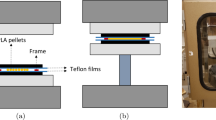Abstract
This paper deals with the investigations of a porous carbon black-filled rubber, tested with regard to its pressure and tension behaviour. In the tension range only uniaxial tests are performed while in the pressure range uniaxial as well as hydrostatic tests are performed. The uniaxial experiments are carried out in a custom-made uniaxial device and the hydrostatic tests in a pressure chamber which is specially developed for this application. The construction and use of the pressure chamber is clearly described in this paper. All experiments are related to the basic elasticity of the material. The viscoelastic behaviour is completely disregarded at this point. Not only the experiments are discussed, also the modelling of the material is looked at. The tested cellular rubber is composed of an incompressible solid phase and a compressible gas phase. For that reason a so-called structural compressibility is observed. The compressible behaviour of cellular rubber is an important property. So the main focus of the paper is on the pressure tests and the simulation of these. The existing material models for rubber like materials only deal with incompressible rubber structures. To represent the compressible behaviour, the Theory of Porous Media is used. The constitutive model is based on a polynomial approach for an incompressible material. This is complemented by a volumetric expansion term with a point of compaction to model the structural compressibility.












Similar content being viewed by others
References
Vroomen G (2004) EPDM-Moosgummi für die Tür- und Fensterdichtungen von Kraftfahrzeugen. GAK 3(57):163–176
Chen W, Lu F, Winfree N (2002) High-strain-rate compressive behavior of a rigid polyurethane foam with various densities. Exp Mech 42:65–73
Dick JS, Annicelli RA (1999) Variation der Vernetzungs- und Treibreaktion für die Steuerung von Zellendichte und -struktur von zelligen Vulkanisaten. GAK 52(4):297–308
Fuchs E, Reinartz KS (2001) Optimierung der Herstellung von Moosgummi. GAK 54(4):245–251
Haberstroh E, Kremers A (2004) Expansion chemisch geschäumter Kautschukmischungen. Kautsch Gummi Kunstst 3(57):105–108
Haberstroh E, Kremers A, Epping K (2005) Extrusion von physikalisch geschäumten Kautschukprofilen. Kautsch Gummi Kunstst 9(58):449–454
Diebels S (1999) A micropolar theory of porous media: constitutive modelling. Transp Porous Med 34:193–208
Diebels S (2000) Mikropolare Zweiphasenmodelle: Modellierung auf der Basis der Theorie Poröser Medien. Habilitationsschrift, Institut für Mechanik (Bauwesen), Nr. II-4, Universität Stuttgart
Ehlers W (1993) Constitutive equations for granular materials in geomechanical context. In: Hutter K (ed) Continuum mechanics in environmental sciences, CISM International Centre for Mechanical Sciences, vol 337. Springer, Berlin, pp 313–402
Avanzini A (2005) Mechanical characterization and modeling of polymeric materials for high-pressure sealing. Exp Mech 45:53–64
Stoll RD, Freudenthal AM, Heller RA (1967) Effects of mean pressure on the behavior of a filled elastomer—immediate goal of the research described in this paper is to gain further insight into the complex mechanical properties of filled elastomers with the ultimate purpose of developing a reliable analytical model. Exp Mech 7:339–345
Bischoff JE, Arruda EM, Grosh K (2001) A new constitutive model for the compressibility of elastomers at finite deformations. Rubber Chem Technol 74:541–559
Attard MM, Hunt GW (2004) Hyperelastic constitutive modeling under finite strain. Int J Solids Struct 41:5327–5350
Clapeyron BPE (1834) Puissance motrice de la chaleur. J Ec R Polytech 14:153–190
Yeoh OH, Flemming PD (1997) A new attempt to reconcile the statistical and phenomenological theories of rubber elasticity. J Polym Sci, Part B, Polym Phys 35:1919–1931
Koprowski-Theiss N, Johlitz M, Diebels S (2010) Modelling of a cellular rubber with nonlinear viscosity functions. Exp Mech. doi:10.1007/s11340-010-9376-9
Seibert H (2010) Konstruktion und Steuerung einer Triaxzelle zur Untersuchung des Kompressionsverhaltens gefüllter Elastomere. Studienarbeit
Bowen RM (1980) Incompressible porous media models by use of the theory of mixtures. Int J Eng Sci 18:1129–1148
de Boer R. Theory of porous media. Springer, Berlin
Coleman BD, Noll W (1963) The thermodynamics of elastic materials with heat conduction and viscosity. Arch Rat Mech Anal 13:167–178
Ehlers W, Eipper G (1999) Finite elastic deformations in liquid-saturated and empty porous solids. Transp Porous Med 34:179–191
Scheday G (2003) Theorie und Numerik der Parameteridentifikation von Materialmodellen der finiten Elastizität und Inelastizität auf der Grundlage optischer Feldmessmethoden. Dissertation, Bericht-Nr. I-11 des Instituts für Mechanik, Lehrstuhl I, Universität Stuttgart
Schwefel HP (1995) Evolution and optimum seeking. Wiley, New York
Acknowledgements
The authors greatfully acknowledge the funding by the German Science Foundation (DFG) under the grant DI 930/9-1. Special thanks of the authors go to Mr. Henning Seibert from the Chair of Applied Mechanics at Saarland University, Saarbrücken, for the construction of the experimental setup.
Author information
Authors and Affiliations
Corresponding author
Rights and permissions
About this article
Cite this article
Koprowski-Theiß, N., Johlitz, M. & Diebels, S. Pressure Dependent Properties of a Compressible Polymer. Exp Mech 52, 257–264 (2012). https://doi.org/10.1007/s11340-011-9489-9
Received:
Accepted:
Published:
Issue Date:
DOI: https://doi.org/10.1007/s11340-011-9489-9




